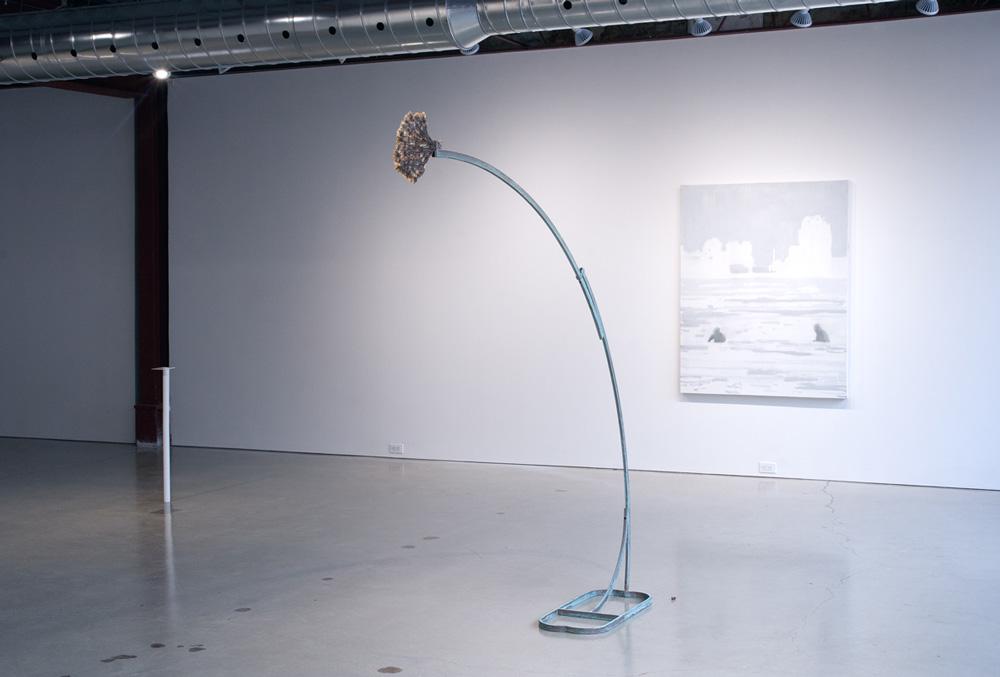Fog. Gas. Acid. Rain. London. Hindenburg. Catastrophe. Aftermath. Ominousness. Ambiguity.
If I take a cue from Kim Neudorf, curator of the “balloon / portal / starres / fiends” group show at London, Ontario’s newest commercial art gallery, DNA Artspace, then a list of actions, words and associations is appropriate to describe the work found there.
Words and language are important to, and within, this exhibition—so much so that a short text available at the gallery and online excerpted from Donald Barthelme’s short story “The Balloon” is essential to a viewer’s “way into” understanding the show in context.
In Barthelme’s story, a large balloon appears over Manhattan. The related excerpt highlighted by Neudorf reads as follows: “It was suggested that what was admired about the balloon was finally this: that it was not limited, or defined. Sometimes a bulge, blister, or sub-section would carry all the way east to the river on its own initiative…This ability of the balloon to shift its shape, to change, was very pleasing, especially to people whose lives were rather rigidly patterned, persons to whom change, although desired, was not available. The balloon, for the twenty-two days of its existence, offered the possibility, in its randomness, of mislocation of the self, in contradistinction to the grid of precise, rectangular pathways under our feet.”
Featuring work of five artists, “balloon / portal / starres / fiends” includes painting, sculpture, photography and film as well as print-based and installation practices. Each artist was asked to respond to text selected by the curator, and then create work for the exhibition. The show also includes an accompanying collaborative text-based piece available in DNA’s bookshop, as well as online.
Like separate-yet-connected characters in a play, each artist’s work holds reflects a sense of the mystery and interpretive quality in Barthelme’s narrative. The sequence of the exhibition helps to connect the works together; each work is a respectable distance from its neighbour, rather than engaging adjacent works directly.
If one was to view the exhibition as a text of its own, Mackenzie Ludlow’s paintings might be seen to act like conjunctive or structural introductions and backdrops within the theatre of the players.
Jenine Marsh’s exciting material engagement, ambiguity and slapstick “faces” relate to the balloon as a spectacle, as do the cool, tight material intrigues of Liza Eurich’s sculptures, which evoke the bizarre and the strange.
Jennifer Martin’s Rising is a projection of two vintage-looking films, cranked down to ultra-slow motion.
One film seems to feature a moon in the twilight, with power lines and the occasional group of birds silhouetted against the new darkening sky. The “moon” wavers and is both rising and stuck in the slow motion of the looped film. The “birds” appear still because of the slowness of the film, which can be seen moving upward across the viewing surface.
Martin’s other film is on a longer loop where the images unfold and appear to double back on themselves. It shows a cloudy surface with a white orb that seems to submerge and rise from it. This ball is the bathing cap of a child floating or swimming in a lake. Not knowing if the swimmer is repeating these actions in reverse, the viewer is also suspended in murkiness and is subsequently enticed to continue watching. The child kicks and comes out of the water, then returns to it, both stuck and surfacing within the film’s duration.
Both paintings by Paolo Fortin describe a moment—perhaps of anticipation—just before an event takes place. Each work is in a light hand creating pasty colours, as if greyed out by something. At D’Arcy Break seems the most unexplained work in the exhibition. Here, two figures crouch in the midst of a field that could be ice, snow or ocean. They gather against what could be a backdrop of a city harbour, or perhaps a silhouette of foreboding mist rolling in. The greys and the uncertainty of the figures’ tasks, as well as their surroundings, make this painting’s indetermination alluring.
Considering “balloon / portal / starres / fiends,” I was reminded of images from 9-11 in which plumes of smoke and dust obstruct and homogenize the air; though these images can seem eerily beautiful, the people figured in them are inside an experience so extreme it could not be fully realized or explained by images or description.
But while images of 9-11 are disturbing, they are also iconic and affective. A similar kind of spectacle and encounter is explored and subtly created by the work in “balloon / portal / starres / fiends,” which bodes well for this new gallery as well as for Neudorf’s own artistic and curatorial projects in future.
This review was corrected on November 5, 2014. The initial post had an incorrect byline. Kyla Brown is the correct author of this review. We regret the error.









